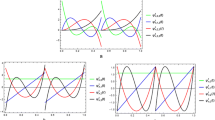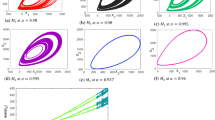Abstract
Real-life epidemic situations are modeled using systems of differential equations (DEs) by considering deterministic parameters. However, in reality, the transmission parameters involved in such models experience a lot of variations and it is not possible to compute them exactly. In this paper, we apply B-spline wavelet-based generalized polynomial chaos (gPC) to analyze possible stochastic epidemic processes. A sensitivity analysis (SA) has been performed to investigate the behavior of randomness in a simple epidemic model. It has been analyzed that a linear B-spline wavelet basis shows accurate results by involving fewer polynomial chaos expansions (PCE) in comparison to cubic B-spline wavelets. We have carried out our developed method on two real outbreaks of diseases, firstly, influenza which affected the British boarding school for boys in North England in 1978, and secondly, Ebola in Liberia in 2014. Real data from the British Medical Journal (influenza) and World Health Organization (Ebola) has been incorporated into the Susceptible-Infected-Recovered (SIR) model. It has been observed that the numerical results obtained by the proposed method are quite satisfactory.



















Similar content being viewed by others
References
Kermack, W. O. and McKendrick, A. G., Contributions to the Mathematical Theory of Epidemics, Proc. Roy. Soc. Edinburgh Sect. A , 1927, vol. 115, no. 772, pp. 700–721.
Bartlett, M. S., Some Evolutionary Stochastic Processes, J. R. Stat. Soc. B , 1949, vol. 11, no. 2, pp. 211–229.
Kendall, D. G., Deterministic and Stochastic Epidemics in Closed Populations, in Proc. of the 3rd Berkeley Symp. on Mathematical Statistics and Probability, 1954 – 1955 : Vol. 4, Berkeley, Calif.: Univ. of California Press, 1956, pp. 149–165.
Hethcote, H. W., The Mathematics of Infectious Diseases, SIAM Rev. , 2000, vol. 42, no. 4, pp. 599–653.
Cunha, A., Jr., Nasser, R., Sampaio, R., Lopes, H., and Breitman, K., Uncertainty Quantification through the Monte Carlo Method in a Cloud Computing Setting, Comput. Phys. Commun. , 2014, vol. 185, pp. 1355–1363.
Walters, R. W. and Huyse, L., Uncertainty Analysis for Fluid Mechanics with Applications, NASA Report CR-2002-211449, ICASE (2002), 50pp.
Robert, C. P. and Casella, G., Monte Carlo Statistical Methods , 2nd ed., New York: Springer, 2004.
Liu, J. S., Monte Carlo Strategies in Scientific Computing , New York: Springer, 2008.
Crestaux, T., Le Maître, O. P., and Martinez, J.-M., Polynomial Chaos Expansion for Sensitivity Analysis, Reliab. Eng. Syst. Saf. , 2009, vol. 94, no. 7, pp. 1161–1172.
Sepahvand, K., Marburg, S., and Hardtke, H.-J., Uncertainty Quantification in Stochastic Systems Using Polynomial Chaos Expansion, Int. J. Appl. Mech. , 2010, vol. 2, no. 2, pp. 305–353.
**u, D. and Karniadakis, G. E., The Wiener – Askey Polynomial Chaos for Stochastic Differential Equations, SIAM J. Sci. Comput. , 2002, vol. 24, no. 2, pp. 619–644.
**u, D. and Karniadakis, G. E., Modeling Uncertainty in Flow Simulations via Generalized Polynomial Chaos, J. Comput. Phys. , 2003, vol. 187, no. 1, pp. 137–167.
Reagana, M. T., Najm, H. N., Ghanem, R. G., and Knio, O. M., Uncertainty Quantification in Reacting-Flow Simulations through Non-Intrusive Spectral Projection, Combust. Flame , 2003, vol. 132, no. 3, pp. 545–555.
Le Maître, O. P., Knio, O. M., Najm, H. N., and Ghanem, R. G., Uncertainty Propagation Using Wiener – Haar Expansions, J. Comput. Phys. , 2004, vol. 197, no. 1, pp. 28–57.
Wiener, N., The Homogeneous Chaos, Amer. J. Math. , 1938, vol. 60, no. 4, pp. 897–936.
Gunzburger, M., Webster, C. G., and Zhang, G., An Adaptive Wavelet Stochastic Collocation Method for Irregular Solutions of Partial Differential Equations with Random Input Data, in Sparse Grids and Applications (Munich, 2012) , J. Garcke, D. Pflüger (Eds.), Lect. Notes Comput. Sci., vol. 97, Cham: Springer, 2014, pp. 137–170.
Le Maître, O. P., Najm, H. N., Ghanem, R. G., and Knio, O. M., Multi-Resolution Analysis of Wiener-Type Uncertainty Propagation Schemes, J. Comput. Phys. , 2004, vol. 197, no. 2, pp. 502–531.
Kaur, N. and Goyal, K., Uncertainty Propagation Using Wiener-Linear B-Spline Wavelet Expansion, Comput. Math. Appl. , 2020, vol. 79, no. 9, pp. 2598–2623.
Kegan, B. and West, R. W., Modeling the Simple Epidemic with Deterministic Differential Equations and Random Initial Conditions, Math. Biosci. , 2005, vol. 195, no. 2, pp. 179–193.
Chen-Charpentier, B. M. and Stanescu, D., Epidemic Models with Random Coefficients, Math. Comput. Model. , 2010, vol. 52, nos. 7–8, pp. 1004–1010.
Santonja, F. and Chen-Charpentier, B. M., Uncertainty Quantification in Simulations of Epidemics Using Polynomial Chaos, Comput. Math. Method. M. , 2012, vol. 2012, no. 3, pp. 449–461.
Roberts, M. G., Epidemic Models with Uncertainty in the Reproduction Number, J. Math. Biol. , 2013, vol. 66, no. 7, pp. 1463–1474.
Omar, A. H. A. and Hasan, Y. A., Numerical Simulations of an SIR Epidemic Model with Random Initial States, Sci. Asia , 2013, vol. 39, pp. 42–47.
Harman, D. B. and Johnston, P. R., Applying the Stochastic Galerkin Method to Epidemic Models with Uncertainty in the Parameters, Math. Biosci. , 2016, vol. 277, pp. 25–37.
Goswami, J. C., Chan, A. K., and Chui, C. K., On Solving First-Kind Integral Equations Using Wavelets on a Bounded Interval, IEEE Trans. Antennas Propag. , 1995, vol. 43, no. 6, pp. 614–622.
Maleknejad, K., Mollapourasl, R., and Shahabi, M., On the Solution of a Nonlinear Integral Equation on the Basis of a Fixed Point Technique and Cubic B-Spline Scaling Functions, J. Comput. Appl. Math. , 2013, vol. 239, no. 1, pp. 346–358.
Maleknejad, K., Nouri, K., and Sahlan, M. N., Convergence of Approximate Solution of Nonlinear Fredholm – Hammerstein Integral Equations, Commun. Nonlinear Sci. Numer. Simul. , 2010, vol. 15, no. 6, pp. 1432–1443.
Murray, J. D., Mathematical Biology , 2nd ed., Biomath., vol. 19, Berlin: Springer, 1993.
Center, C. D. S., News and Notes: Influenza in a Boarding School, The BMJ , 1978, vol. 1, no. 6112, pp. 586–590.
Saltelli, A., Tarantola, S., Campolongo, F., and Ratto, M., Sensitivity Analysis in Practice: A Guide to Assessing Scientific Models , New York: Wiley, 2004.
Balaman, Ş. Y., Decision-Making for Biomass-Based Production Chains: The Basic Concepts and Methodologies , New York: Acad. Press, 2018.
Warder, S. C., Sensitivity Analysis, Uncertainty Quantification and Parameter Estimation for a Numerical Tide and Storm Surge Model, PhD Thesis , Imperial College, London, 2020, 189 pp.
Appendix: Additional Results and Technical Notes for the Ebola Response Modeling Tool, Centers for Disease Control and Prevention, https://www.cdc.gov/mmwr/preview/mmwrhtml/su63e0923a2.htm (Sept 2014).
Ebola Virus Disease Update: West Africa, The World Health Organization (WHO), https://www.who.int/csr/don/2014\_08\_19\_ebola/en/ (19 Aug 2014).
Meltzer, M. I., Atkins, C.Y., Santibanez, S., Knust, B., Petersen, B.W., Ervin, E. D., Nichol, S. T., Damon, I. K., and Washington, M. L., Estimating the Future Number of Cases in the Ebola Epidemic: Liberia and Sierra Leone (2014–2015), Centers for Disease Control and Prevention, https://www.cdc.gov/mmwr/preview/mmwrhtml/su6303a1.htm (Sept 2014).
WHO Finds 70 Percent Ebola Mortality Rate, The World Health Organization (WHO), https://www.aljazeera.com/news/2014/10/15/who-finds-70-percent-ebola-mortality-rate (2014).
Suthanthirakumaran, M., Modelling Ebola Using an SIR Model , : North London Collegiate School, 2014.
Funding
The second author is grateful to the Science and Engineering Research Board (SERB) for MTR/2017 /000619 grant in support of this research work.
Author information
Authors and Affiliations
Corresponding authors
Ethics declarations
The authors declare that they have no conflicts of interest.
Additional information
MSC2010
34F05, 60H10
Rights and permissions
About this article
Cite this article
Kaur, N., Goyal, K. Uncertainty Quantification of Stochastic Epidemic SIR Models Using B-spline Polynomial Chaos. Regul. Chaot. Dyn. 26, 22–38 (2021). https://doi.org/10.1134/S1560354721010020
Received:
Revised:
Accepted:
Published:
Issue Date:
DOI: https://doi.org/10.1134/S1560354721010020




